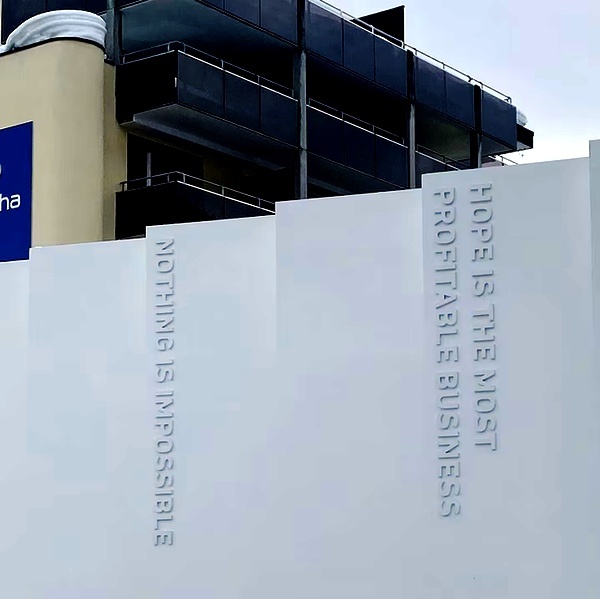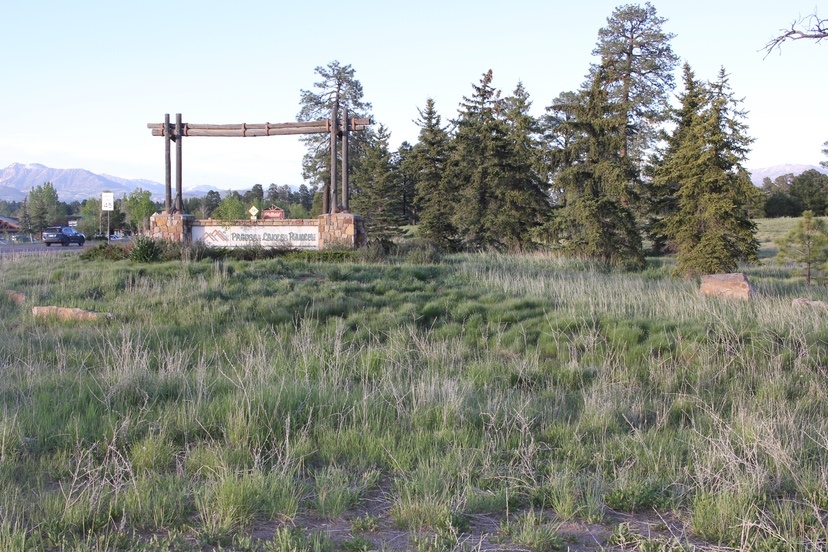If memory serves, the monument sign shown in the photo above was installed at the intersection of South Pagosa Boulevard and Highway 160 in around 1995, by developer Tom Grant, the fellow who developed the City Market shopping center and who donated the land for the nearby Pagosa Springs Medical Center.
The sign reads, “Pagosa Lakes Ranch”. But I believe the full meaning was more along the lines of, “Pagosa Lakes Part-Commercial and Part-Residential Subdivision Ranch.” The property faces Highway 160 and also runs along South Pagosa Boulevard.
Mr. Grant never got around to developing the Ranch, for whatever reasons.
One of our humor writers, Louis Cannon, shared a photo in a recent column, showing a message posted by the United Arab Emirates (UAE) outside their pavilion at this year’s World Economic Forum.
The message:
Hope is the Most Profitable Business

With that message in mind, let’s listen to some comments made by developer Doug Dragoo at a May 21 work session held by the Archuleta Board of County Commissioners. Mr. Dragoo is apparently hoping to purchase the “Pagosa Lakes Ranch” property —about 100 acres across the street from the medical center, to create a mixed-use subdivision similar to the one his company — Colorado Outdoors LLC — is in the process of building out in Montrose, Colorado, on 160 acres there.
And possibly similar to the one envisioned by Tom Grant 30 years ago?
At the BOCC work session, Mr. Dragoo was proposing to provide a vacant parcel — or, alternatively, a new building for lease — to accommodate the BOCC’s desire for a new Administration Building. The BOCC has not yet explained to the taxpayers how they can afford yet another new building, but hope is indeed the most profitable business in Pagosa Springs.
The theoretical subdivision would be about 40% commercial and about 60% residential.
Mr. Dragoo:
“Our plan is to also build 120 units of workforce housing, which will be AMI-restricted.”
(“AMI” means “Area Median Income” and most government-subsidized housing projects limit the amount of income a household can earn, to qualify for the subsidized housing.)
“That’s kind of how this whole project started,” said Mr. Dragoo. “We realized, in one of the other projects we were doing, that we were attempting to sell sites to other businesses and convince them to move into the community… and they would hire people, and the people would come to town, and they would say, ‘This is great; I’m making $18 an hour. But I can’t find any place to rent…’ And so that’s how we started doing workforce housing. To create a place, where the people who work in these business, could live.
“That allowed us to be able to sell our commercial [parcels]. So the people who owned the banks and the restaurants and the hotels could have places for the [employees] to live.
“It seems a little unbelievable that this happens in our world today, but the reality is, workers can’t find a place to live. And if they can’t find a place to live, then they don’t move here, and you can’t run your hotel, because you don’t have people to clean the rooms or work in the restaurants…”
Mr. Dragoo then noted that our local County and Town governments have ‘opted into’ Colorado’s Prop 123 program, which can supply funding for workforce and low-income housing. The state has programs to help fund infrastructure; other programs provide grants and low interest loans. Mr. Dragoo’s company has its own grant writer, he said, to help chase government subsidies. He told the BOCC that it’s impossible to build new apartments at a price that allows the rents to be affordable.
“Pagosa actually has an interesting designation, because you’re in this thing called a ‘rural resort’. And that means your AMIs can be slightly higher.”
Meaning that a developer can charge higher rents.
“So our whole program, then, is to build this whole project around [the new County admin building] and around workforce housing, as the beginning.”
This is a slightly different approach for the current Colorado Outdoors project in Montrose, which was conceptually built around a fishing equipment manufacturer, Mayfly Outdoors, headed by Mr. Dragoo’s son, David Dragoo.
Doug Dragoo and his realtor, Shelley Low, rattled off a list of the types of businesses that will no doubt be moving in — eventually — once the County offices and the workforce housing are in place.
Eventually.
Ms.Low:
“The whole point is, it’s got to be synergistic with the residential, and with the commercial. It’s something that Pagosa has never seen, and it’s just perfect timing. And we have the perfect developer…”
Well, that’s a bit of a stretch… that a blend of residential and commercial is something Pagosa has never seen. But it sounds like something a savvy realtor might confidently state as a fact.
We’ve had an historically synergistic blend of commercial and residential in downtown Pagosa for over 100 years. The mixed-use area around City Market could have remained a synergistic mix, but a huge portion of the residential has recently been converted into vacation rentals.
And we have a 90-acre development in Aspen Village, platted in 2006 as a synergistic blend of commercial and residential — but, thus far, it’s less than 50% built out, 20 years later.
Are Ms. Low and Mr. Dragoo now proposing yet another “synergistic” development that will be sitting mostly vacant 20 years from now… with additional under-utilized streets and infrastructure that we can’t afford to maintain?
I have to ask that question, because our BOCC was not willing to ask it. At least, not directly, during the work session.
Commissioner Ronnie Maez did note that the requirements baked into the County Land Use Regulations — some of which are purely aesthetic — have had a tendency to drive up the cost of construction, and he asked Mr. Dragoo to comment on that.
I’ve written about the same issue here in the Daily Post, and I was curious how Mr. Dragoo would respond.

